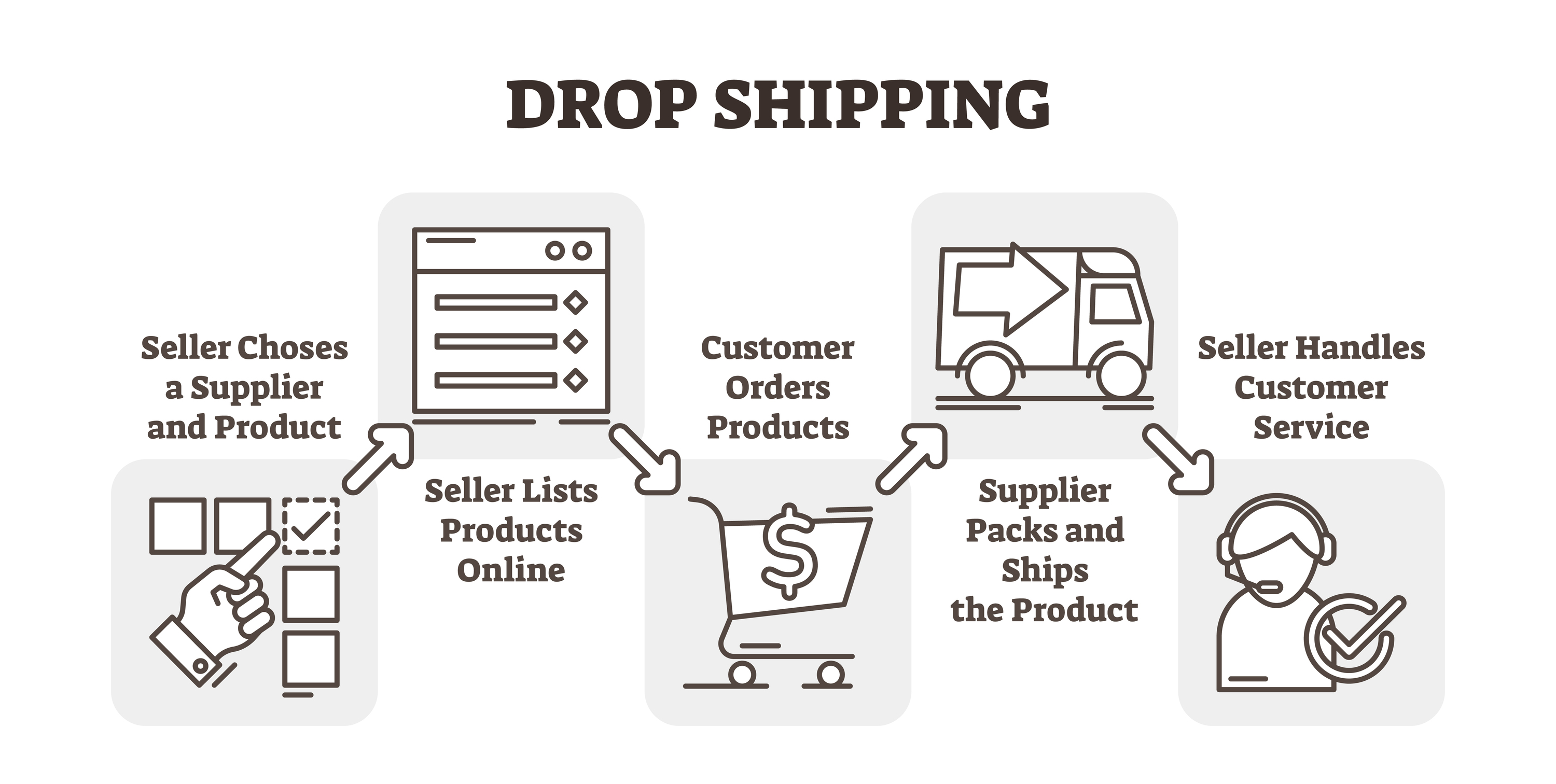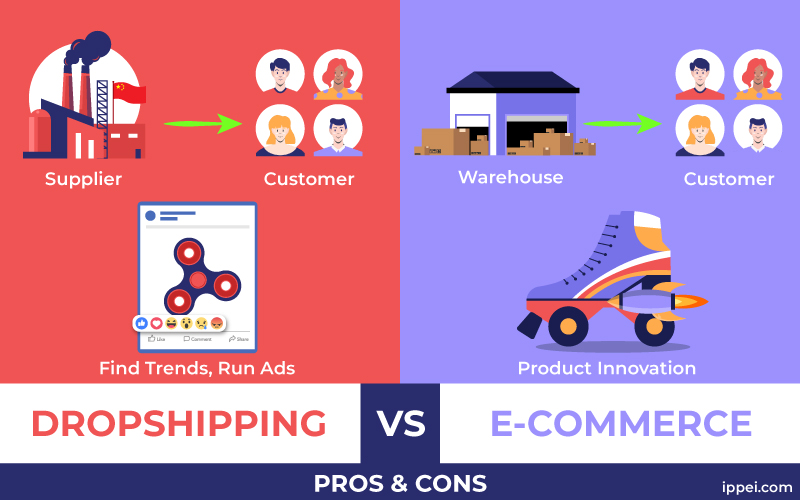Understanding the Basics of Drop Shipping and Affiliate Marketing
When it comes to starting an online business, two popular models often come to mind: drop shipping and affiliate marketing. While both models have gained significant attention in recent years, they differ in their approach to selling products and services online. In this article, we will delve into the core concepts of drop shipping and affiliate marketing, exploring their benefits and drawbacks, and helping you decide which model is best suited for your online business.
Drop shipping is a retail fulfillment method where a store does not keep the products it sells in stock. Instead, it partners with a third-party supplier who ships products directly to the customer. This model allows entrepreneurs to start an online store without holding any inventory, reducing the risk of upfront costs and inventory management. On the other hand, affiliate marketing involves promoting products or services from another company and earning a commission on sales or referrals made through one’s unique affiliate link.
Both drop shipping and affiliate marketing offer a range of benefits, including low overhead costs, flexibility, and the potential for high profits. However, they also come with their own set of challenges, such as shipping and inventory management issues in drop shipping, and the need to build trust and credibility with customers in affiliate marketing. As we explore the pros and cons of each model, it’s essential to consider your individual needs and goals, as well as the level of effort and resources you’re willing to invest in your online business.
When comparing drop shipping vs affiliate marketing, it’s crucial to understand the key differences between the two models. Drop shipping requires a more hands-on approach, as you’ll need to manage customer service, returns, and refunds. Affiliate marketing, on the other hand, involves promoting products and earning a commission, without the need to handle customer support or inventory management.
By understanding the basics of drop shipping and affiliate marketing, you’ll be better equipped to make an informed decision about which model is right for your online business. In the following sections, we’ll explore the pros and cons of each model in more detail, providing you with the insights and knowledge you need to succeed in the world of e-commerce.
The Pros and Cons of Drop Shipping: Is it Right for You?
Drop shipping is a popular online business model that offers a range of benefits, including flexibility, low overhead costs, and the potential for high profits. However, it also comes with its own set of challenges, such as shipping and inventory management issues. In this section, we’ll delve into the pros and cons of drop shipping, helping you decide if it’s the right model for your online business.
One of the main advantages of drop shipping is its low overhead costs. Since you don’t need to hold any inventory, you can start an online store without a significant upfront investment. Additionally, drop shipping allows you to offer a wide range of products to your customers, without having to worry about storing and managing inventory. This can be especially beneficial for entrepreneurs who want to test different products and markets without committing to a large inventory.
Another benefit of drop shipping is its flexibility. With the ability to ship products directly from the supplier to the customer, you can operate your online store from anywhere with an internet connection. This makes it an ideal model for entrepreneurs who want to work remotely or have a location-independent business.
However, drop shipping also comes with its own set of challenges. One of the main drawbacks is the lack of control over shipping and inventory management. Since you’re not physically handling the products, you may have limited control over shipping times, product quality, and inventory levels. This can lead to customer satisfaction issues and negative reviews, which can harm your online business.
Additionally, drop shipping often involves working with multiple suppliers, which can be time-consuming and challenging. You’ll need to research and vet potential suppliers, negotiate prices and terms, and manage relationships with multiple partners. This can be overwhelming, especially for new entrepreneurs who are just starting out.
Despite these challenges, many entrepreneurs have found success with drop shipping. By carefully selecting suppliers, managing customer expectations, and providing excellent customer service, you can build a successful and profitable online business with drop shipping.
How to Succeed with Affiliate Marketing: Tips and Strategies
Affiliate marketing is a popular online business model that involves promoting products or services from another company and earning a commission on sales or referrals made through your unique affiliate link. To succeed with affiliate marketing, it’s essential to choose the right products, build a loyal audience, and create effective promotional content.
When selecting products to promote, consider the needs and interests of your target audience. Choose products that are relevant, high-quality, and offer a unique solution to a problem. Research the product’s reputation, reviews, and ratings to ensure it’s a good fit for your audience.
Building a loyal audience is critical to success in affiliate marketing. Create valuable content that educates, entertains, or inspires your audience, and engage with them through social media, email marketing, or blog comments. Build trust and credibility by being transparent about your affiliation with the product and providing honest reviews.
Effective promotional content is also crucial to success in affiliate marketing. Use a variety of content formats, such as blog posts, videos, podcasts, or social media posts, to promote products and reach your audience. Use attention-grabbing headlines, compelling copy, and eye-catching visuals to grab the attention of your audience and drive sales.
Transparency and trust are essential in affiliate marketing. Disclose your affiliation with the product clearly and prominently, and provide honest reviews and recommendations. Avoid using deceptive or misleading tactics to promote products, as this can damage your reputation and lose the trust of your audience.
Some successful affiliate marketers use a variety of strategies to promote products, including product reviews, tutorials, and comparisons. Others use social media influencers or email marketing campaigns to reach their audience. Experiment with different strategies to find what works best for your audience and products.
By following these tips and strategies, you can succeed with affiliate marketing and build a profitable online business. Remember to stay up-to-date with industry trends, best practices, and changes in the affiliate marketing landscape to ensure long-term success.
A Comparison of Drop Shipping and Affiliate Marketing: Which is More Profitable?
When it comes to choosing between drop shipping and affiliate marketing, one of the most important factors to consider is profit potential. Both models can be profitable, but they have different commission structures, product prices, and marketing costs. In this section, we’ll compare the profit potential of drop shipping and affiliate marketing, providing examples of successful entrepreneurs in both fields.
Drop shipping typically offers a higher profit margin than affiliate marketing, as you’re selling products directly to customers and earning the full sale price. However, you’ll also need to consider the costs of marketing, shipping, and customer service, which can eat into your profits. Affiliate marketing, on the other hand, offers a commission-based structure, where you earn a percentage of the sale price for each product sold through your unique affiliate link.
The commission rates for affiliate marketing vary widely depending on the product and program, but they can range from 1% to 50% or more. Drop shipping, on the other hand, typically offers a profit margin of 10% to 30% or more, depending on the product and supplier. However, you’ll also need to consider the costs of shipping, packaging, and customer service, which can reduce your profit margin.
Marketing costs are also an important factor to consider when comparing the profit potential of drop shipping and affiliate marketing. With drop shipping, you’ll need to invest in marketing campaigns to drive traffic to your website and attract customers. With affiliate marketing, you’ll need to invest in marketing campaigns to promote products and attract affiliates. However, affiliate marketing programs often provide marketing materials and support, which can reduce your marketing costs.
Examples of successful entrepreneurs in both drop shipping and affiliate marketing include Shopify’s Oberlo, which offers a drop shipping platform for entrepreneurs, and Amazon’s Associates program, which offers a commission-based affiliate marketing program for entrepreneurs. Other successful entrepreneurs in drop shipping include SaleHoo, which offers a wholesale directory for entrepreneurs, and AliExpress, which offers a drop shipping platform for entrepreneurs. Successful entrepreneurs in affiliate marketing include Pat Flynn, who earns millions of dollars per year through affiliate marketing, and Michelle Schroeder-Gardner, who earns over $100,000 per month through affiliate marketing.
Ultimately, the profit potential of drop shipping and affiliate marketing depends on your individual skills, experience, and resources. Both models can be profitable, but they require different strategies, skills, and investments. By understanding the profit potential of each model, you can make an informed decision about which one is right for your online business.
Overcoming Common Challenges in Drop Shipping and Affiliate Marketing
Both drop shipping and affiliate marketing offer lucrative opportunities for entrepreneurs, but they also come with unique challenges. Understanding and addressing these challenges is crucial for success in either field. In this section, we’ll explore common obstacles faced by entrepreneurs in both drop shipping and affiliate marketing, and provide practical tips for overcoming them.
One of the most significant challenges in drop shipping is managing relationships with suppliers. Finding reliable suppliers who can provide high-quality products and timely shipping is essential. However, this can be a daunting task, especially for new entrepreneurs. To overcome this challenge, it’s essential to research potential suppliers thoroughly, read reviews, and ask for references. Building strong relationships with suppliers can help ensure a smooth and profitable drop shipping experience.
Another challenge in drop shipping is managing customer expectations. Since entrepreneurs don’t hold any inventory, they have limited control over shipping times and product quality. To overcome this challenge, it’s essential to set clear expectations with customers, provide accurate product information, and offer excellent customer service. This can help build trust and loyalty with customers, even in the face of unexpected issues.
Affiliate marketing also comes with its unique set of challenges. One of the most significant challenges is building a loyal audience. With so many affiliate marketers promoting the same products, it can be difficult to stand out and build a loyal following. To overcome this challenge, it’s essential to create high-quality content that provides value to readers, engage with them on social media, and offer exclusive promotions and discounts.
Another challenge in affiliate marketing is staying up-to-date with industry trends and product offerings. With new products and technologies emerging all the time, it can be difficult to keep up. To overcome this challenge, it’s essential to stay informed through industry blogs, attend webinars, and participate in online communities. This can help entrepreneurs stay ahead of the curve and promote the most relevant and profitable products.
Both drop shipping and affiliate marketing require a significant amount of marketing effort to succeed. However, with the right strategies and mindset, entrepreneurs can overcome common challenges and achieve success. By understanding the unique challenges of each model and taking proactive steps to address them, entrepreneurs can build a profitable and sustainable online business.
In the context of drop shipping vs affiliate marketing, it’s essential to consider the unique challenges of each model when deciding which path to take. While drop shipping offers more control over the sales process, it also requires more effort in managing supplier relationships and customer expectations. Affiliate marketing, on the other hand, offers more flexibility and scalability, but requires more effort in building a loyal audience and staying up-to-date with industry trends. By understanding these challenges and taking proactive steps to address them, entrepreneurs can make an informed decision and achieve success in either field.
Building a Sustainable Online Business: Tips for Long-Term Success
Building a sustainable online business requires a long-term perspective and a willingness to adapt to changing market conditions. Whether you’re involved in drop shipping or affiliate marketing, it’s essential to focus on strategies that promote stability and growth. In this section, we’ll explore tips for building a sustainable online business, including diversifying income streams, focusing on customer satisfaction, and continuously improving marketing strategies.
Diversifying income streams is crucial for building a sustainable online business. By relying on a single source of income, you’re vulnerable to market fluctuations and unexpected changes. To mitigate this risk, consider diversifying your income streams by exploring new markets, products, or services. For example, if you’re involved in drop shipping, consider adding affiliate marketing to your portfolio or vice versa. This can help you spread your risk and increase your overall revenue.
Focusing on customer satisfaction is also essential for building a sustainable online business. Happy customers are more likely to return and recommend your business to others, which can lead to increased sales and revenue. To focus on customer satisfaction, prioritize excellent customer service, offer high-quality products, and continuously gather feedback from your customers. This can help you identify areas for improvement and make data-driven decisions to enhance your business.
Continuously improving marketing strategies is also critical for building a sustainable online business. The online landscape is constantly evolving, and what works today may not work tomorrow. To stay ahead of the curve, stay informed about the latest marketing trends and best practices. Attend webinars, read industry blogs, and participate in online communities to stay up-to-date. This can help you identify new opportunities and stay competitive in a rapidly changing market.
In the context of drop shipping vs affiliate marketing, it’s essential to consider the long-term implications of each model. While drop shipping offers more control over the sales process, it also requires more effort in managing supplier relationships and customer expectations. Affiliate marketing, on the other hand, offers more flexibility and scalability, but requires more effort in building a loyal audience and staying up-to-date with industry trends. By understanding these differences and focusing on strategies that promote stability and growth, entrepreneurs can build a sustainable online business that generates long-term revenue.
Ultimately, building a sustainable online business requires a commitment to excellence, a willingness to adapt, and a focus on long-term growth. By diversifying income streams, focusing on customer satisfaction, and continuously improving marketing strategies, entrepreneurs can build a successful online business that generates revenue for years to come. Whether you’re involved in drop shipping or affiliate marketing, remember that success is a marathon, not a sprint. Stay focused, stay adaptable, and always keep your customers in mind.
Real-Life Examples of Successful Drop Shipping and Affiliate Marketing Businesses
While theory is essential, real-life examples can provide valuable insights into the world of drop shipping and affiliate marketing. In this section, we’ll explore successful businesses in both fields, highlighting their strategies, successes, and lessons learned.
One successful example of a drop shipping business is SaleHoo, a wholesale directory that connects entrepreneurs with verified suppliers. SaleHoo’s founders, Simon Slade and Mark Ling, started their business with a simple idea: to provide a platform for entrepreneurs to find reliable suppliers. Today, SaleHoo has over 8,000 suppliers and 137,000 members, generating millions of dollars in revenue each year.
Another successful example of a drop shipping business is Shopify’s own success story. Shopify, a popular e-commerce platform, started as a drop shipping business and eventually grew into a multi-billion dollar company. Shopify’s founders, Tobias Lütke, Daniel Weinand, and Scott Lake, started their business by selling snowboards online. They eventually expanded their product line and developed a platform that would help other entrepreneurs start their own online businesses.
In the affiliate marketing space, one successful example is Pat Flynn’s Smart Passive Income. Pat Flynn, a well-known affiliate marketer, started his business by promoting products related to online marketing and entrepreneurship. Today, Smart Passive Income generates over $100,000 per month in revenue, making it one of the most successful affiliate marketing businesses online.
Another successful example of an affiliate marketing business is Michelle Schroeder-Gardner’s Making Sense of Cents. Michelle Schroeder-Gardner, a personal finance blogger, started her business by promoting financial products and services. Today, Making Sense of Cents generates over $100,000 per month in revenue, making it one of the most successful affiliate marketing businesses in the personal finance niche.
These examples demonstrate that success is possible in both drop shipping and affiliate marketing. By understanding the strategies and tactics used by these successful businesses, entrepreneurs can gain valuable insights into what works and what doesn’t. Whether you’re just starting out or looking to scale your existing business, these examples can provide inspiration and guidance on your journey to success.
In the context of drop shipping vs affiliate marketing, it’s essential to note that both models require dedication, hard work, and a willingness to learn. While drop shipping offers more control over the sales process, affiliate marketing offers more flexibility and scalability. By understanding the strengths and weaknesses of each model, entrepreneurs can make informed decisions about which path to take.
Ultimately, success in drop shipping and affiliate marketing requires a combination of the right strategy, the right mindset, and a willingness to adapt to changing market conditions. By studying the successes and failures of others, entrepreneurs can gain valuable insights into what works and what doesn’t, and make informed decisions about their own businesses.
Making the Right Choice for Your Online Business: Drop Shipping or Affiliate Marketing?
Choosing the right online business model is a crucial decision that can make or break your entrepreneurial journey. In this article, we’ve explored the world of drop shipping and affiliate marketing, highlighting their core concepts, advantages, and disadvantages. We’ve also discussed common challenges, provided real-life examples of successful businesses, and offered guidance on how to build a sustainable online business.
When it comes to drop shipping vs affiliate marketing, the choice ultimately depends on your individual needs and goals. If you’re looking for a more hands-on approach to selling products online, drop shipping may be the better choice. However, if you prefer a more passive approach to earning income online, affiliate marketing may be the way to go.
Regardless of which model you choose, it’s essential to remember that success requires dedication, hard work, and a willingness to learn. By understanding the strengths and weaknesses of each model, you can make informed decisions about which path to take and create a successful online business that generates revenue for years to come.
In the context of drop shipping vs affiliate marketing, it’s also important to consider your target audience, marketing strategies, and financial goals. By taking a holistic approach to your online business, you can create a sustainable and profitable venture that meets your needs and exceeds your expectations.
Ultimately, the key to success in drop shipping and affiliate marketing is to stay focused, stay adaptable, and always keep your customers in mind. By providing value to your audience, building trust and transparency, and continuously improving your marketing strategies, you can create a successful online business that generates long-term revenue and helps you achieve your financial goals.
In conclusion, choosing the right online business model is a critical decision that requires careful consideration and research. By understanding the pros and cons of drop shipping and affiliate marketing, you can make an informed decision about which path to take and create a successful online business that meets your needs and exceeds your expectations.
Remember, success in drop shipping and affiliate marketing requires a combination of the right strategy, the right mindset, and a willingness to adapt to changing market conditions. By staying focused, staying adaptable, and always keeping your customers in mind, you can create a successful online business that generates revenue for years to come.








